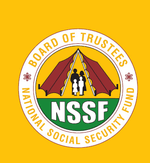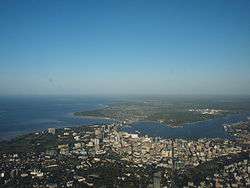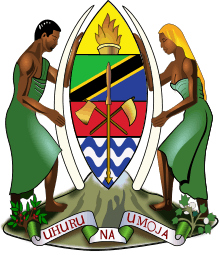National Social Security Fund (Tanzania)
 | |
| Quasi-Government | |
| Industry | Social Security |
| Predecessor | National Provident Fund |
| Founded | 1997 |
| Headquarters | B. Mkapa Pension Towers, Dar es Salaam, Tanzania |
Number of locations | 24 Offices |
Area served | Tanzania Mainland |
Key people |
Abubakar S. Rajabu Chairman Dr. Ramadhani K. Dau Director General |
| Products | Pension fund |
| Revenue |
|
| Total assets |
|
| Members | 521,629 (2011) [2] |
Number of employees | 941 (2011) [2] |
| Parent | Government of Tanzania |
| Website | Homepage |
The National Social Security Fund (NSSF) is a government agency responsible for the collection, safekeeping, responsible investment and distribution of retirement funds of all employees in all sectors of the Tanzanian Economy that do not fall under the Governmental Pension schemes. There are two other Pension fund organizations in the country; the Public Service Pensions Fund for all employees working directly under the government and the Parastatal Pension Fund for all employees working under governmental Parastatals.[3][4] NSSF was founded in 1997 as a successor to the defunct National Provident Fund. NSSF covers all other employers in the country and participation for both employers and employees is compulsory. NSSF is both a Pension fund and Provident fund.[5]
.jpg)
History
The Social Security scheme dates back to 1964 where all social security issues were handled by the National Provident Fund. The National Provident Fund Act was enacted in 1964 and amended further in 1968.[6] The Provident fund became defunct in 1997 and the Act of Parliament No. 28 of 1997 replaced the National Provident fund with the National Social Security Fund.[7]
Corporate Affairs
Management and Ownership
The Company is entirely owned by the government of Tanzania and is one of the 4 Social security funds in the country. The others being the: Parastatal Pension Fund; Public Service Pensions Fund and the Local Authority Pension Fund.[8] All the funds used to be in charge of separate sectors of the workforce, however regulation in the early 2000s liberalized the sector and all fund corporations were allowed to enroll all employees in the formal and informal sector.[4]
Board Members
The NSSF is managed by a board of 12 members not including the director general. All board members must be Tanzanian nations and none of the board members are permitted to hold executive positions. The Board has three specialized committees to manage operations: the Finance and Investment Committee, the Audit Committee and the Staff Committee.[2]
Business Trends
A majority of NSSF's revenue comes from employee and employers contributions. The program is a compulsory scheme and is financed with a contribution of an employee's 20% salary. 10% of the funds is paid for by the employee and the other 10% is paid by the employer.
The key trends for NSSF over recent years are shown below (as at year ending 30 June):
| 2007 | 2008 | 2009 | 2010 | 2011 | |
|---|---|---|---|---|---|
| Registered Employees | 14,927 | 15,560 | 16,592 | 17,666 | 18,779 |
| Registered Employers | 408,970 | 447,797 | 475,993 | 506,218 | 521,629 |
| Amount Collected (TZS Mil) | 162,379 | 205,385 | 255,271 | 300,089 | 356,512 |
| Benefits Paid (TZS Mil) | 50,522 | 81,818 | 85,120 | 110,135 | 136,596 |
| Notes | [9] | [10] | [10] | [2] | [2] |
Headquarters
The National Social Security Fund head office is at the Benjamin Mkapa Pension Towers in Dar-es-Salaam. The building used to be called Mafuta House. The company has an office in all major cities and all regional capitals.
Investments
Investment Portfolio
Composition of NSSF Investment Portfolio as at 30th June 2011
The fund has an investment policy which requires the fund to invest 75% of its total annual sources. The fund traditionally invests in Government Securities, Fixed Deposits, Corporate Bonds, Loans, Equities and Real Estate. Most funds are held in Loans and government securities and a large percentage of the income comes from interest collections. Recently the fund has began to invest heavily in real estate and have undertaken multi-billion shillings construction projects in various parts of the country.
NSSF Investment Portfolio 2006/07 – 2010/11[2]
| Investment Category (TZS Million) | 2006/07 | 2007/08 | 2008/09 | 2009/10 | 2010/11 |
|---|---|---|---|---|---|
| Government Securities | 159,832 | 164,969 | 158,838 | 185,316 | 271,171 |
| Fixed Deposits | 35,545 | 68,298 | 145,292 | 180,963 | 161,711 |
| Corporate Bond | 12,755 | 10,804 | 8,054 | 6,418 | 800 |
| Loans | 117,315 | 182,251 | 283,949 | 386,763 | 453,403 |
| Equity | 96,911 | 61,047 | 62,988 | 69,303 | 77,999 |
| Real Estate | 108,292 | 182,908 | 198,558 | 200,440 | 251,538 |
| Total Investment Base | 530,652 | 670,280 | 857,681 | 1,029,206 | 1,216,624 |
Major Real-estate Projects
Kigamboni Bridge

The Kigamboni bridge is a joint venture between the Government of Tanzania (40%) and the National Social Security Fund (60%). The Bridge is 680m long and connects the Kurasini in Dar-es-salaam to Kigamboni. Furthermore, the money will involve upgrading of the nearby highway infrastructure to reduce congestion around the bridge. The bridge is to cost $140 million and will be operational early 2016.[11] The bridge will contain a toll plaza and will be the country's first toll road. The Fund aims to recover its revenue through toll booth collections.
Dege Eco Village
Dege eco village is one of the largest investment projects conducted by NSSF. The satellite township is located in Kigamobni area and covers an area of 300 acres. The state-of-the-art estate will house over 7000 homes and is anticipated to be completed in 2017. The estate will not only have homes but have schools, supermarkets, security infrastructure and various amenities. The investment project is worth $544 million and is a joint venture between the fund and Azimino Estate Housing Limited.[12]
See also
References
- ↑ "NSSF to invest heavily in coffee, cotton, cashewnut processing in three regions". IPP Media. IPP Media. 4 June 2015. Retrieved 28 December 2015.
- 1 2 3 4 5 6 7 "NSSF 2010/2011 Annual Report". nssf.or.tz. NSSF. Retrieved 28 December 2015.
- ↑ "About Us - PPF Pensions Fund". www.ppftz.org. Retrieved 2015-12-28.
- 1 2 "About Us - The Public Service Pensions Fund". www.pspf-tz.org. Retrieved 2015-12-28.
- ↑ "National Social Security Fund - Overview". www.nssf.or.tz. Retrieved 2015-12-28.
- ↑ "The National provident Fund Act 1964" (PDF). saflii.org. Government of Tanzania. 1964. Retrieved 28 December 2015.
- ↑ Mdoe, Giza (20 August 2014). "NSSF launches scheme for Tanzanians in Diaspora". Retrieved 28 December 2015.
- ↑ "DISCUSSION QN: QN. What are the following; NSSF, LAPF, PPF, and PSPF?". discussionqn.blogspot.ca. Retrieved 2015-12-28.
- ↑ "NSSF Annual Report 2006-2007". nssf.or.tz. NSSF. Retrieved 28 December 2015.
- 1 2 "Annual Report 2007/08". nssf.or.tz. NSSF. Retrieved 28 December 2015.
- ↑ "Mkapa lauds Kikwete on Kigamboni bridge". www.dailynews.co.tz. Retrieved 2015-12-28.
- ↑ "JK applauds of Kigamboni satellite township model". IPP Media. 7 July 2014. Retrieved 28 December 2015.

